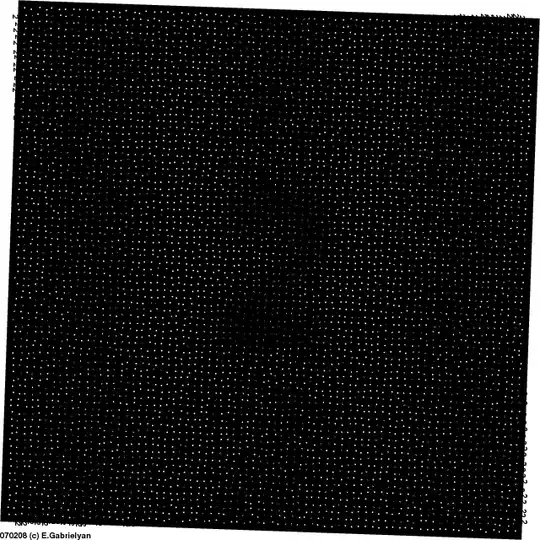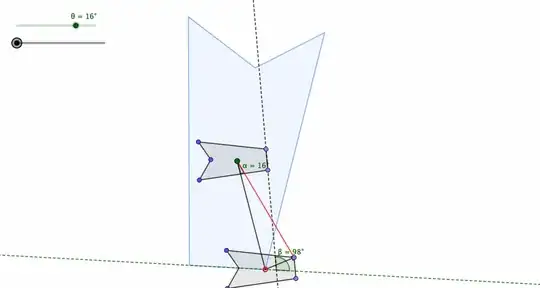Firstly let's try to clear things up by solving another case.
Suppose we have a pattern on the complex plane and the patterns dimentions is P by P. Now suppose the function $B_1(x, y)$ gives us the inverted brightness of the point $x + iy$ the result is a number in $[0, 1]$ if it is black 1 and if white 0.
Now Define $B_{1y}(x) = B_1(x, y)$. Now we want to make this function more easy to work with(smooth it) by deriving its Fourier series:
$$
B_{1,k,y}(x) \approx A_0 + \sum_{n=1}^{k} (A_n \cos(\frac{2\pi nx}{P}) + B_n \sin(\frac{2\pi nx}{P}))
$$
Now we rotate our pattern by $\theta$ radians by multiplying each point by the rotation matrix:
$$
(x', y') = (x\cos\theta - y\sin\theta, x\sin\theta + y\cos\theta)
$$
if now we put this pattern on a new plane and we define all the functions the same but instead of $B_1$ and $B_{1y}$ we have $B_2$ and $B_{2y}$
So now for this rotated pattern we have:
$$
B_{2,k,y}(x) = B_1(x\cos\theta + y\sin\theta, y\cos\theta - x\sin\theta) = B_{1,k,y\cos\theta - x\sin\theta}(x\cos\theta + y\sin\theta)
$$
substituting:
$$B_{2,k,y}(x)\approx A_0 + \sum_{n=1}^{k} (A_n \cos(\frac{2\pi n(x\cos\theta + y\sin\theta)}{P}) + B_n \sin(\frac{2\pi n(x\cos\theta + y\sin\theta)}{P}))$$
Now if we put these two onto each other the inverted brightness at the point$(x, y)$ would be $max(B_1(x, y), B_2(x, y))$
Now for your case, the apparent brightness at each point would still be calculated this way but the second black page with dots would be modeled independently from the first page with one exception : the configuration of dots is like the "2"s. and we know that the "2"s are "the same shape" so with this in mind, let's make a "pattern" of only one "2". if we only have one "2" in our plane and our opaque sheet is rotating, the brightness of each point is derived the same way(keep this in mind for later). the position of each hole in the un-rotated opaque page is the position of each"2" on our stationary page. so if we invert the opaque page ($B_2$)
and rotate it on our "2" page the total inverted brightness function is derived by:
$$
B(x, y) = max(1-B_1(x\cos\theta + y\sin\theta, y\cos\theta - x\sin\theta), B_1(x, y))
$$
for small $\theta$ we have $\sin\theta \approx \theta$ and $\cos\theta \approx 1$
so here :
$$
B(x, y) \approx max(1-B_1(x , y), B_1(x, y)) = 1
$$
which basically says if you put a sheet and its inverted verison you will get pitch black (logical)(here we don't have pitch black because the holes aren't exactly on the "2"s)
but let's add a second term to each of our estimations:
$$
\sin \theta \approx \theta - \frac{\theta^3}{6}
$$
and
$$
\cos \theta \approx 1 - \frac{\theta^2}{2}
$$
so
$$
B(x, y) = max(1-B_1(x(1 - \frac{\theta^2}{2}) + y(\theta - \frac{\theta^3}{6}), y(1 - \frac{\theta^2}{2}) - x(\theta - \frac{\theta^3}{6})), B_1(x, y))
$$
so this explains why a "2" appears when we have a small rotation:
remember $B_{1,k,y}$ and $B_{2,k,y}$? well we know that the inverted opaque page has holes and its holes are at the positions of the "2"s so if we now modify our $B_{1y}$ and $B_{2y}$ such that $B_{1,k,y}$ has a sort of sine structure around the hole(at the hole $B_{1y}$ is maximum(1) and around it $B_{1,k,y}$ is a bit less than one) (we have smoothed it) and do the same with $B_{2,k,y}$ they will have a remarkably similar structure (one is the inverted of the other). This is exactly what we did with the fourier transform : if we set k at a sufficiently low number(1) we will have just a sine wave for both where the extrema's are equal.
When we add the rotation of the opaque page for sufficiently low angles of rotation, since our pattern object ("2") is continuous and doesn't change drastically when we move a little on it, it is like we are transfering the sine wave to right or left and up or down (very little) and so the repeated object will more or less appear because the maximum and the minimum of our new rotated sine wave will(more or less) align with the stationary sine wave's maximum and minimum.(this is right or left)
as the angle gets bigger there are two matters at hand:
1.the extrema of the rotated sine wave will line up with the extrema of the starionary sine waves which are above or below the mentioned sine wave. (up or down) this, combined with the (left or right) motion that we mentioned creates a spinning and magnifying effect(since with the increase of the angle, extrema line-up points end up farther from the center of rotation)
2. if the angle of rotation gets too large the estimation falls apart because then we can't neglect the rotation and estimate it as moving.
I'm NOT a native speaker sorry for bad english AND also it is my first ANSWER I hope it is acceptable.

